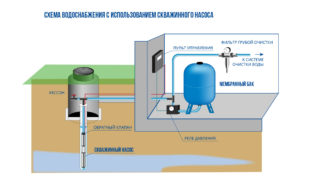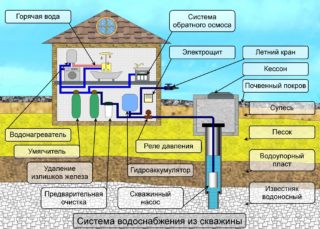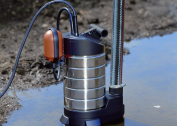Properly equipped autonomous water supply of a private house will allow you to permanently get rid of water problems and huge tariffs for payment. Together with the organization of the well, the owner receives perfectly clean water, provided that the source is properly maintained.
The principle of operation and design of an autonomous water supply system for a private house
 The personal use well in the adjoining area fulfills the task of uninterrupted supply of water resources to the house. If necessary, to carry out its correct arrangement, you need to know by what principle it functions. The device should be properly designed, therefore it is better to give this role to professionals.
The personal use well in the adjoining area fulfills the task of uninterrupted supply of water resources to the house. If necessary, to carry out its correct arrangement, you need to know by what principle it functions. The device should be properly designed, therefore it is better to give this role to professionals.
To automate the process of starting water into a stationary pipeline, it is necessary to equip the system with a hydraulic accumulator. With its help, a stable pressure and the accumulation of a specific amount of water will be maintained (depending on the volume of the tank).
The device is equipped with a membrane unit, which is divided into two halves: air and water. When water enters the reservoir, the membrane expands and creates a lot of pressure in the air zone, as a result of which pressure is supplied to the pipeline.
As soon as the necessary pressure is accumulated in the accumulator, the relay will turn off the pump and start it if the owner of the house opens the tap and uses the water accumulated in the tank.
The choice of water supply
 The accuracy of the autonomous water supply at home directly depends on the source that will serve it.
The accuracy of the autonomous water supply at home directly depends on the source that will serve it.
- Artesian well. Its depth is about 150 m. Drilling of such sources is carried out by means of special equipment; accordingly, the development of a “clean” well will be much more expensive. At the same time, it will last 50 years and provide the resource with a large country house.
- Well "on the sand." It makes its way to a depth of 15 to 50 meters, depending on the groundwater passage zone. The service life of such a well will be no more than 15-20 years, which is significantly different from the previous version.
- Normal well. Often its depth exceeds 10-15 meters. The main disadvantage is the low level of purity of water. Additional waste of filters and regular maintenance of the source from siltation will be required.
Punching any well before connecting it to the pipeline, it is necessary to analyze the water for the presence of harmful metals and other chemical elements.
Installation Steps
 Before proceeding with the installation, it is necessary to make sure that at hand there is an autonomous water supply scheme for a private house from the tank. It is permissible to carry out its development on your own, if you have drawing skills. The preparatory project should contain information on the components of the future pipeline, as well as its dimensions and connections to electric pumping equipment. After preparing the drawing, rough work is performed on the ground. They are divided into stages.
Before proceeding with the installation, it is necessary to make sure that at hand there is an autonomous water supply scheme for a private house from the tank. It is permissible to carry out its development on your own, if you have drawing skills. The preparatory project should contain information on the components of the future pipeline, as well as its dimensions and connections to electric pumping equipment. After preparing the drawing, rough work is performed on the ground. They are divided into stages.
- When a well or a well is already fully organized and does not require an arrangement of casing, you can proceed to the next stage.
- Digging trench. It is easier to use special equipment, while taking into account that the depth of the laying of pipes from the well to the house should be at least 50 cm.
- A water pipe and an electric cable for the pump, which is installed in a caisson near the well, are laid in this trench.
- The pipe is connected to the pump, and a pipe of the required depth is immersed from the pump into the source.A strainer is put on.
- The end of the pipe, which approaches the house, is introduced into the first room, where the resource will flow. Usually it is a bathroom, but you can use the nearest room. For example, a kitchen or dining room.
- It remains only to carry out the internal organization of the pipeline. A trench is buried, an electric pump is connected. The plumbing is ready for use.
It is first necessary to determine how much water is needed, and from this, build on the depth of the source and power of the pumping station.
Operation and maintenance
Drillers who organized the well are required to provide instructions for use. It usually contains the following recommendations:
- The first ten starts, the pump must be regulated - carefully turn the valve when taking water.
- The first selection of water from the well should be carried out within two hours, no more (less can be, for example, for irrigation).
- Be sure to send water for analysis to check its quality. It is advisable to do this once every six months.
When servicing in the country or in a private house, it is important to follow these rules:
- timely audit of casing integrity;
- control the pressure of the pump with the valve turned on and off;
- flush the well only in case of siltation.
When the casing wall collapses, the well is re-drilled.
Advantages and disadvantages of water supply of a private house
Autonomous water supply of a private house has several advantages and disadvantages. In most cases, the normal operation of sources depends on compliance with operating rules. If they are carried out, the plumbing system will have such advantages:
- Ease of use and independence from main water supply.
- Pure water suitable for any purpose.
- It is not necessary to carry out additional warming with the correct arrangement of the well.
- Maintenance services are provided.
Among the shortcomings should be highlighted:
- Maintenance costs.
- Installation problems if there is no free space.
- Registration of a source in the state register.
- The risk of soil erosion and building sludge in the event of a well in the basement.
If the technology of use and organization of water supply is observed, the exploitation of a natural resource does not cause problems.


